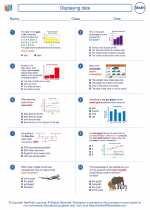Displaying data -> linear growth
Linear Growth
Linear growth is a type of growth in which a quantity increases or decreases by the same absolute amount over a constant interval of time. In other words, the relationship between the quantity and the time is linear, resulting in a straight-line graph when the quantity is plotted against time. This type of growth is commonly represented by the equation y = mx + b, where y is the quantity, x is the time, m is the rate of growth, and b is the initial value of the quantity.
Key Concepts
- Rate of Growth (m): This represents the amount by which the quantity changes over a specific unit of time. It determines the steepness of the line on the graph.
- Initial Value (b): This is the starting value of the quantity at the beginning of the time period under consideration. It is the y-intercept of the graph.
- Linear Equation: The equation y = mx + b is the standard form for representing linear growth, where y is the dependent variable (quantity) and x is the independent variable (time).
- Graphical Representation: When graphed, linear growth results in a straight line with a constant slope, reflecting the consistent rate of change over time.
Examples
Let's consider an example of linear growth:
A car rental company charges a fixed fee of $50 plus $20 per day. The total cost (C) of renting a car for a certain number of days (d) can be represented by the equation C = 20d + 50. In this case, the cost increases by $20 for each additional day, demonstrating linear growth.
Study Guide
To understand linear growth, it's important to focus on the following key points:
- Recognizing linear relationships in real-world scenarios
- Understanding the role of rate of growth and initial value in the linear equation y = mx + b
- Graphing linear growth and interpreting the slope and y-intercept of the line
- Applying linear growth concepts to solve problems involving quantities that change at a constant rate over time
Practice identifying linear growth in various contexts and working with linear equations to reinforce your understanding of this fundamental concept in mathematics.
Hope this study guide helps you in understanding linear growth. If you have any further questions, feel free to ask!
.◂Math Worksheets and Study Guides Eighth Grade. Displaying data

 Worksheet/Answer key
Worksheet/Answer key
 Worksheet/Answer key
Worksheet/Answer key
 Worksheet/Answer key
Worksheet/Answer key
 Worksheet/Answer key
Worksheet/Answer key
